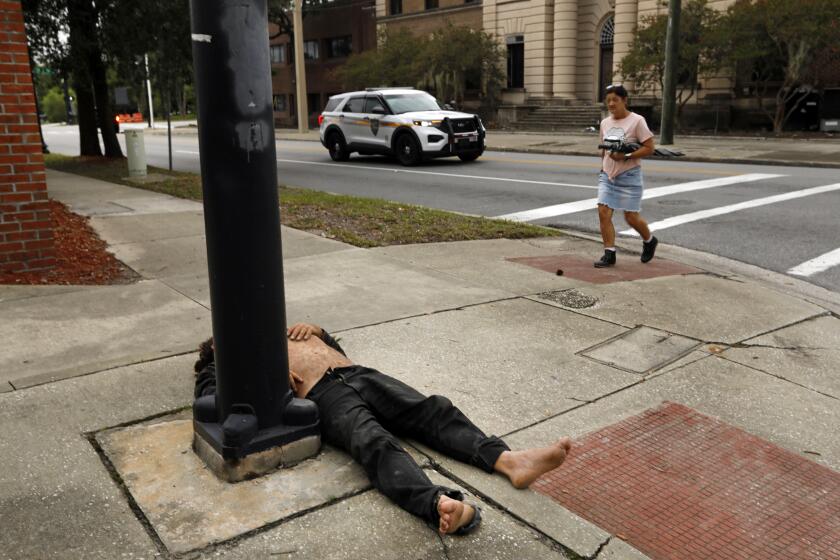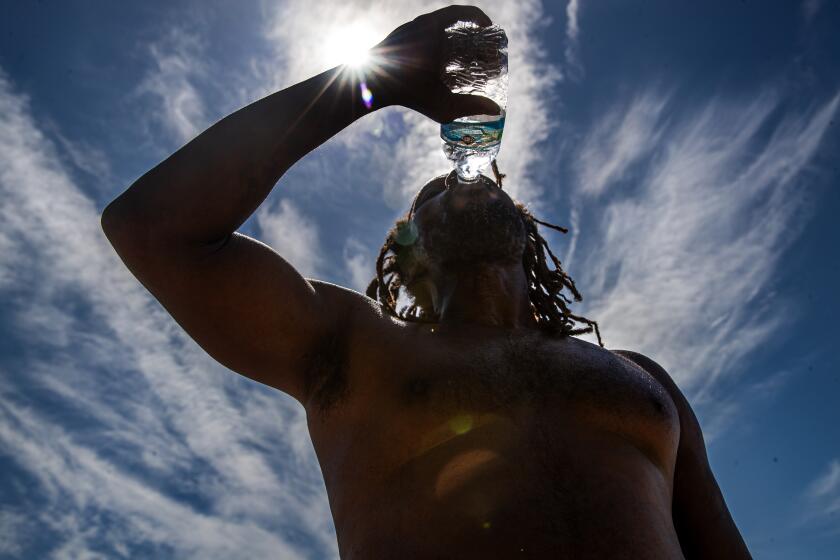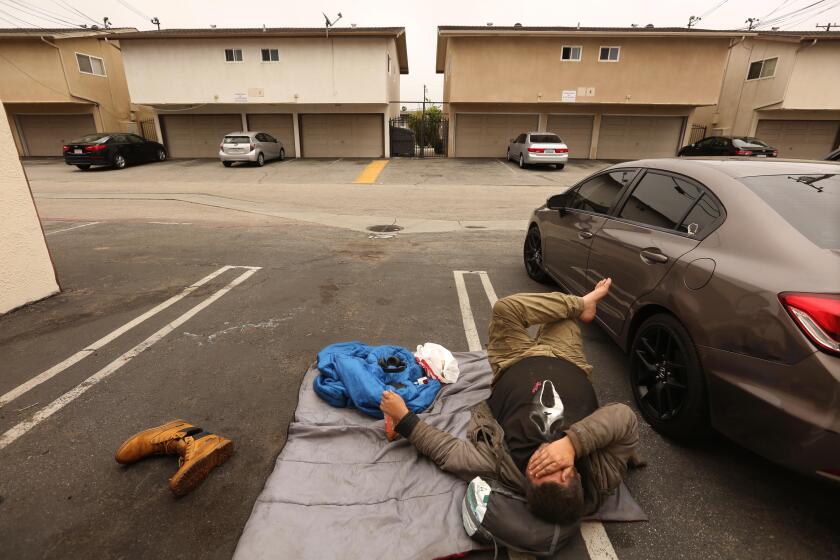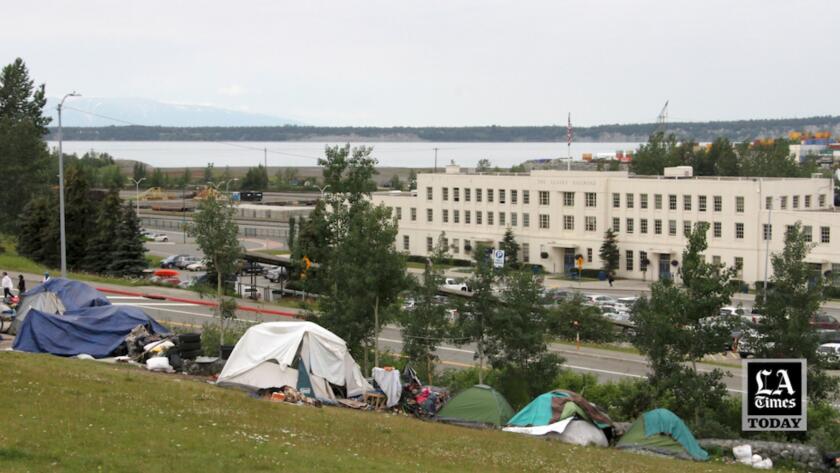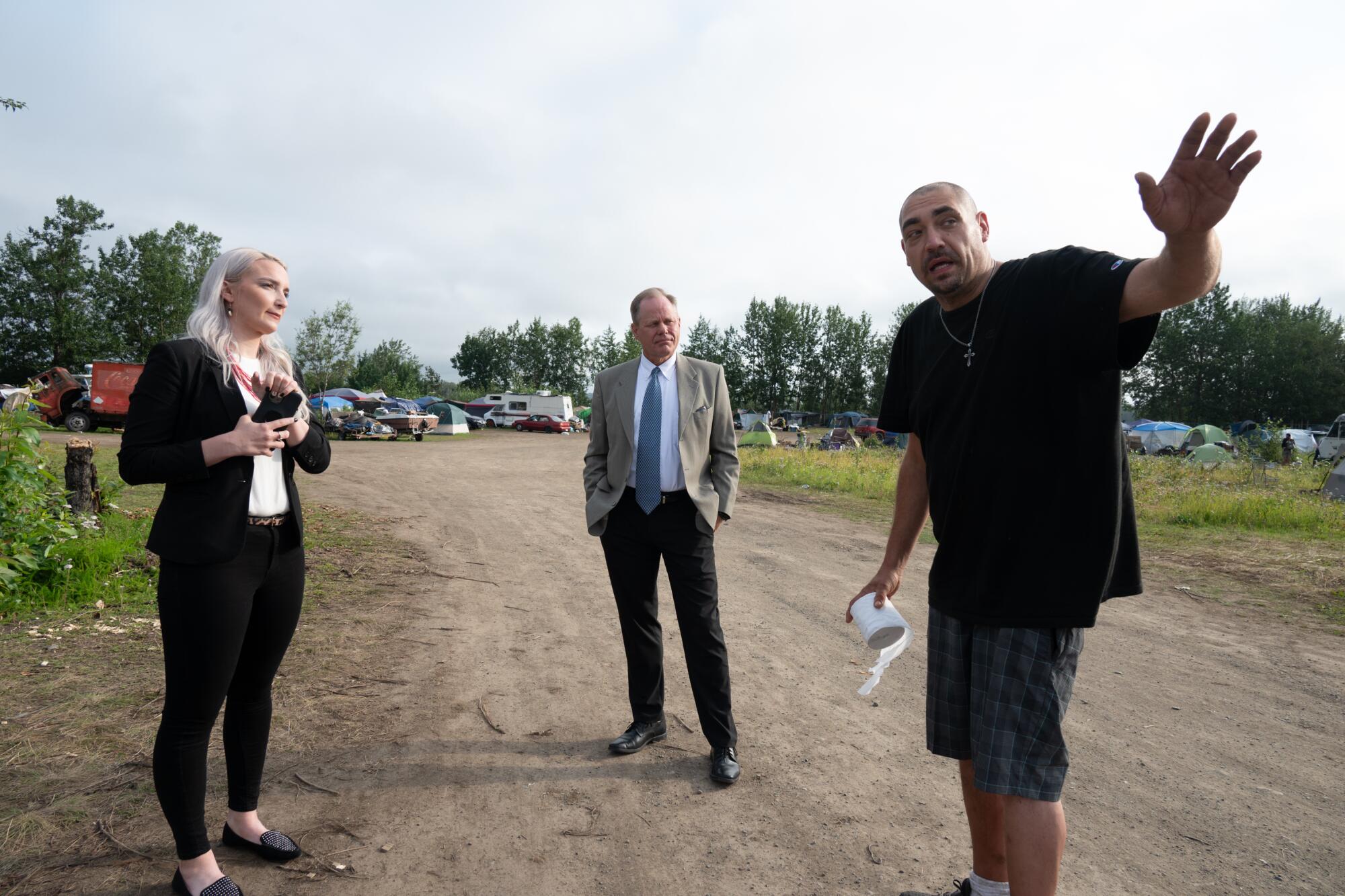
- Share via
ANCHORAGE — A man clutching a roll of toilet paper barreled toward Mayor Dave Bronson.
He pointed to the portable toilets the city had just installed at the sprawling homeless encampment the mayor was visiting.
There were just four toilets for hundreds of people. They often overflow with feces, said the 46-year-old man, who gave his name as Joel.
Bronson promised to bring more toilets. Then he pivoted to his latest idea: offering homeless people in Anchorage a one-way ticket to warmer cities — such as Los Angeles — this winter.
“Hey, let me ask you something,” Bronson began. “If I offered you an airline ticket—”
“I wouldn’t take it!” Joel yelled. “Alaska’s my home. How dare you? How dare you!”
“What I want to see is you people take your head out of your a— and figure this sh— out.”
Jacksonville, Fla., has a good track record for moving homeless people off the streets. But as the city continues to grow, local builders and advocates worry about creating another housing crisis like the one in Los Angeles.
The mayor’s grand scheme to solve one of urban America’s most intractable problems wasn’t going over so well.
Bronson’s unfunded plan to fly homeless people out has become a major flashpoint in Anchorage, which, like cities across the West, is grappling with a burgeoning homelessness crisis and a lack of both emergency shelters and affordable housing.

In May, the city closed a mass shelter at the Sullivan Arena, a sports venue that housed upward of 500 people during cold months. It had been operating on and off as an emergency shelter since 2020, when the COVID-19 pandemic began.

Subscribers get exclusive access to this story
We’re offering L.A. Times subscribers special access to our best journalism. Thank you for your support.
Explore more Subscriber Exclusive content.
Bronson said it needed to return to hosting hockey games and rock concerts.
After the Sullivan closed, homeless camps in Anchorage’s parks and greenbelts exploded in size. Hundreds of people live outdoors in this city of 288,000, and officials currently have no plans for a new winter shelter.
During a point-in-time census in January, Anchorage recorded 1,760 people staying on the streets and in overnight shelters — up from 1,494 in 2022.
In a rural California town, there is little help for the unhoused, who are endangered by extreme heat.
So far this year, at least 31 people believed to be homeless have died outdoors in Anchorage, surpassing last year’s record high of 24, said Alexis Johnson, the city’s homelessness coordinator.
Most died from drug overdoses, especially from fentanyl, she said. Some froze to death.
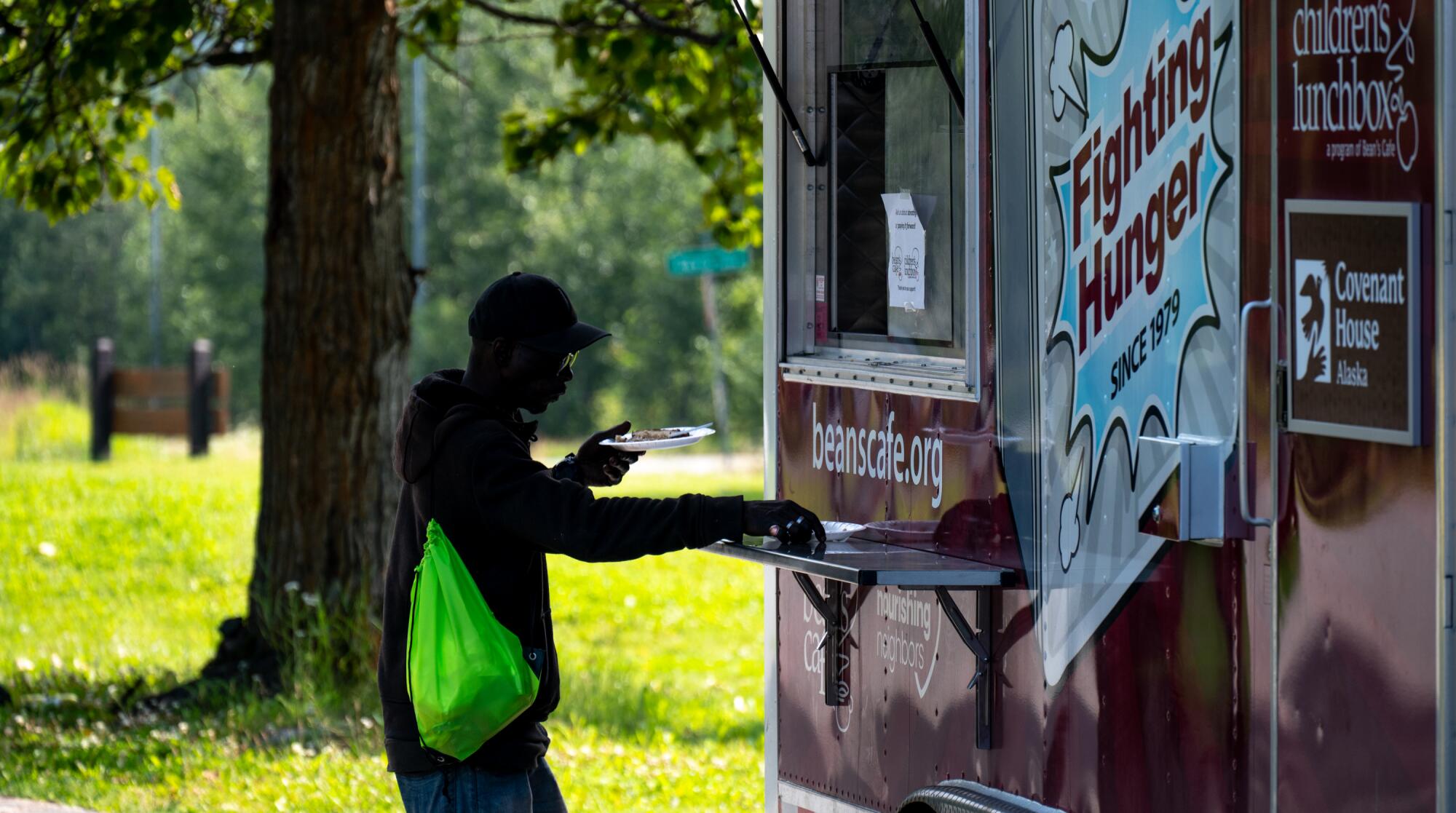
Winter in Alaska’s largest city brings months of subfreezing temperatures. Days have almost no sunlight.
This summer has been rainy — leading to a lot of foot injuries for unhoused people who can’t keep dry — and all of the shelters in Anchorage have been running at capacity, said Jessica Parks, chief operating officer for the Anchorage Coalition to End Homelessness.
Last week, Bronson, wearing a suit and tie, walked among scores of tents on the grassy, city-owned lot on Third Avenue, which has become one of Anchorage’s biggest encampments. Recently, he said, a camper threatened him with a hatchet.
Sign up for This Evening's Big Stories
Catch up on the day with the 7 biggest L.A. Times stories in your inbox every weekday evening.
You may occasionally receive promotional content from the Los Angeles Times.
The plane ticket idea, he said, was an “act of desperation.”
“You’ve got something we don’t have,” he told a Times reporter, referencing sunny Southern California. “You’ve got good weather all year long.”
Told that homeless people in Los Angeles increasingly are dying on the streets from heat-related illnesses, he responded: “What are we supposed to do?”
Last year, the Salvation Army offered tickets out of Anchorage to a few homeless people who could prove they had family or friends to stay with elsewhere.
Bronson wants to greatly expand such efforts and plans to ask the Anchorage Assembly, the city’s governing body, for around $50,000 for a relocation program. Homeless people could choose to go anywhere in the Lower 48 — preferably somewhere warmer, such as California — or elsewhere in Alaska.
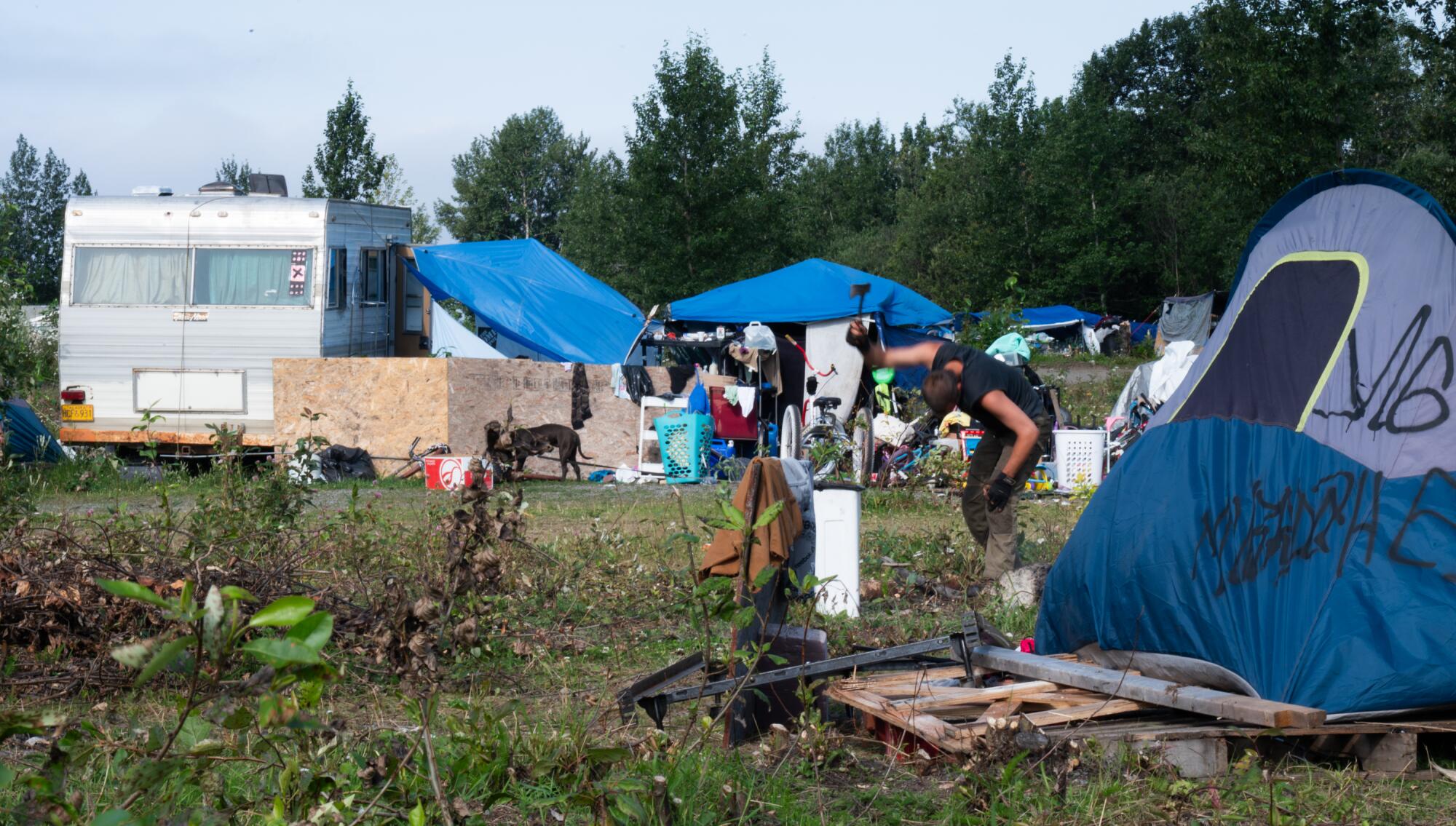
A ticket to L.A., he said, is cheaper than paying about $100 per person per day for shelter and food.
Bronson, a conservative Republican, swore he wasn’t picking on the Golden State. But he added that he had read the book “San Fransicko: Why Progressives Ruin Cities,” which blames California’s liberal leaders for the state’s homelessness crisis.
“I don’t want to get the folks of L.A. mad at me,” he said. “I don’t want the mayor mad at me.”
It is not new for cities to buy one-way bus or plane tickets to ship homeless people out of town. One such program, called Homeward Bound in San Francisco, was started by Gov. Gavin Newsom in 2005, when he was the city’s mayor. Portland, Ore., had a similar program. So did Pomona.
Andrew Truelove arrived in Los Angeles with big dreams. A month later, he was sleeping in the parking lot behind a Torrance shopping center.
But Bronson’s pitch comes at a time when the movement of vulnerable people to other places is a political lightning rod.
Last year, Republican governors in Texas, Arizona and Florida began busing and flying asylum-seeking migrants to Democratic strongholds to protest liberal immigration policies. Texas Gov. Greg Abbot has sent more than 200 migrants to Los Angeles since June.
“Republicans want to tell a false story that Democratic-run cities are falling apart,” Zach Seidl, a spokesman for Mayor Karen Bass, told The Times last month in response to Bronson’s plan. “But in reality, these ridiculous stunts just show the difference between leaders who confront crises by rolling up their sleeves to address issues and leaders who confront crises by rolling over to shift the problem.”
Seidl said Wednesday that Bronson had not contacted Bass.
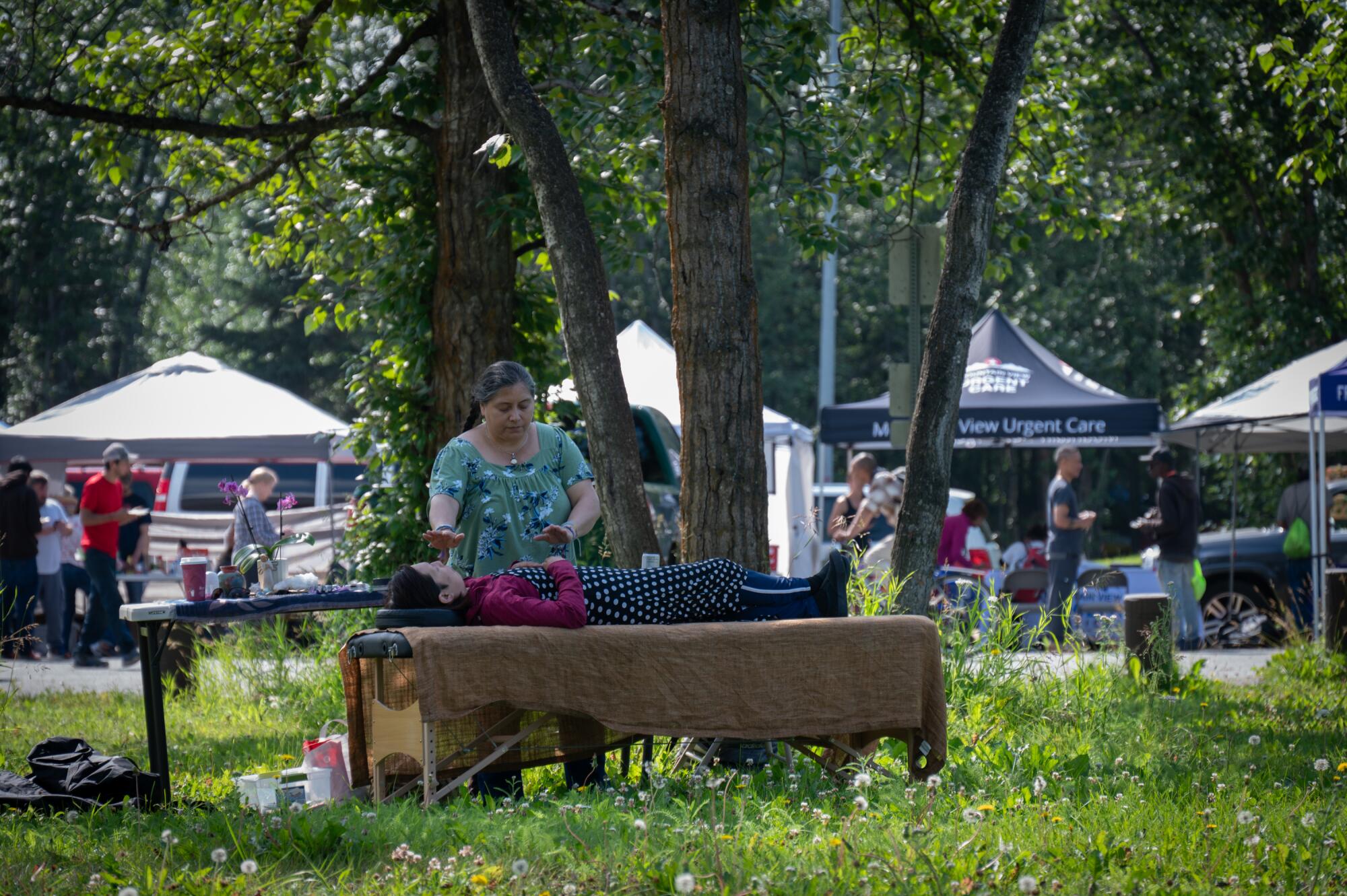
Los Angeles County already has more than 75,500 unhoused people — a number that has grown more than 70% since 2015, despite hundreds of millions of dollars spent on shelter, permanent housing, outreach and campsite cleanups.
In Anchorage, the city government has been working closely with local nonprofits to buy hotels and convert them to housing. But squabbling between the mayor and the more liberal Assembly has slowed efforts to address the homelessness crisis.
Bronson, a former U.S. Air Force and commercial airline pilot, took office in 2021. He was narrowly elected, riding a wave of support from conservative voters who were, like him, opposed to coronavirus mask and vaccine mandates.
He is now up for reelection and is no stranger to controversy. He once spoke in defense of anti-maskers who wore yellow Stars of David with the words “Do Not Comply” to an Anchorage Assembly meeting. He later apologized. He briefly shut off fluoride in the city’s water system until he realized it was required by law.
Last summer, Bronson’s administration closed the shelter at the Sullivan Arena and bused homeless people to a city-run campground in Centennial Park frequented by bears.
L.A. has a multitude of vacant lots that might be used as temporary, secure places to get people off the streets. Simple enough, right?
The campsite borders the Chugach Mountains and the U.S. Army’s and Air Force’s Joint Base Elmendorf-Richardson — a wooded facility so well-known for its ursine visitors it is nicknamed J-BEAR.
Last summer, state wildlife authorities killed five black bears after they broke into homeless people’s tents in the park. The city eventually shut down the campsite and reopened the Sullivan shelter.
Last fall, the Assembly nixed Bronson’s plans for a new insulated, tentlike structure that would have sheltered up to 150 people. Construction stopped after Bronson’s administration gave the contractor the go-ahead to spend millions of dollars to start building — without approval from the Assembly, which is required by law.
“Anchorage is facing a massive under-investment from the feds and the state that is leaving the local government holding the bag,” said Christopher Constant, Assembly chairman. “And we are struggling and fighting each other, trying to find a solution to a problem that needs outside funding.”
Constant doubts the Assembly will approve funding for airline tickets. The idea, he said, has “racist overtones” because more than 40% of Anchorage’s unhoused population are Indigenous people whose families have been in Alaska for thousands of years.
“If we’re talking about a $50,000 investment in plane tickets, we’re talking about a massive deportation,” Constant said.

On a sunny morning last week, Thraine Katchatag carried a plate of potatoes, biscuits and gravy from a nearby rehab facility back to the tent he shares with a friend in the Third Avenue encampment. He laughed when asked whether he would take a plane ticket.
“I will never leave Alaska,” he said. “This is my state.”
Katchatag, 67, is Native Alaskan — Athabaskan and Iñupiat — from Shaktoolik, a village of about 200 people on a narrow, fast-eroding sand spit on the Bering Sea.
The village bans the sale and importation of alcohol. Katchatag, a carpenter, said he came to Anchorage in 2018 because “the village is dry, and I like to drink.”
He spent part of last winter at the former Sockeye Inn, a hotel that was converted to a homeless shelter run by Catholic Social Services and is geared toward older adults and people with health and mobility issues. Katchatag said he was kicked out because he had to be taken three days in a row to a city-funded sleep-off center to sober up after he was intoxicated in public.
Nancy Cabinboy, 40, sat on a rock nearby, nursing a bloody knee she got by falling off a bicycle.
She is Siberian Yupik and Iñupiat, originally from Nome. She said she lost her children — she didn’t say when or why — and life just got hard.
If the mayor offered her a plane ticket, she wouldn’t know where to go.
“I’ve never left Alaska before,” Cabinboy said. Maybe she’d try Mexico or Las Vegas. Somewhere warm. Somewhere different.
“I’m just trying to get my life going, you know?” Cabinboy said. “It’s been a really rough time.”
She spent last winter at the Sullivan, where she always worried that someone would steal her belongings. She doesn’t know what she’ll do this year.
The encampment is on the vacant lot where the Alaska Native Medical Center — severely damaged in a magnitude 9.2 earthquake in 1964 — once stood.
There is no running water. In the summer, the sun shines 22 hours a day, making it hard to sleep. Noise from the nearby railroad tracks, military jets flying overhead, music blasting from tents, and people fighting is constant.
One campsite, where a busted recreational vehicle was parked next to a tent, was strewn with children’s toys. A pink tricycle. A plastic shopping cart. A Little Tykes toddler slide.
A man emerged, carrying a toddler. A child with long blond hair and dirty cheeks, probably 6 or 7, peeked out from behind a tarp then darted into the RV.
Sitting on a wooden pallet a few feet away, Ane Opetaia, 38, who works as a hotel housekeeper and stays at the camp, said she was appalled by the mayor’s idea.
“They’d send us to L.A.?” she asked, laughing. “How about sending us to hell and back? Los Angeles? This is Los Anchorage.”
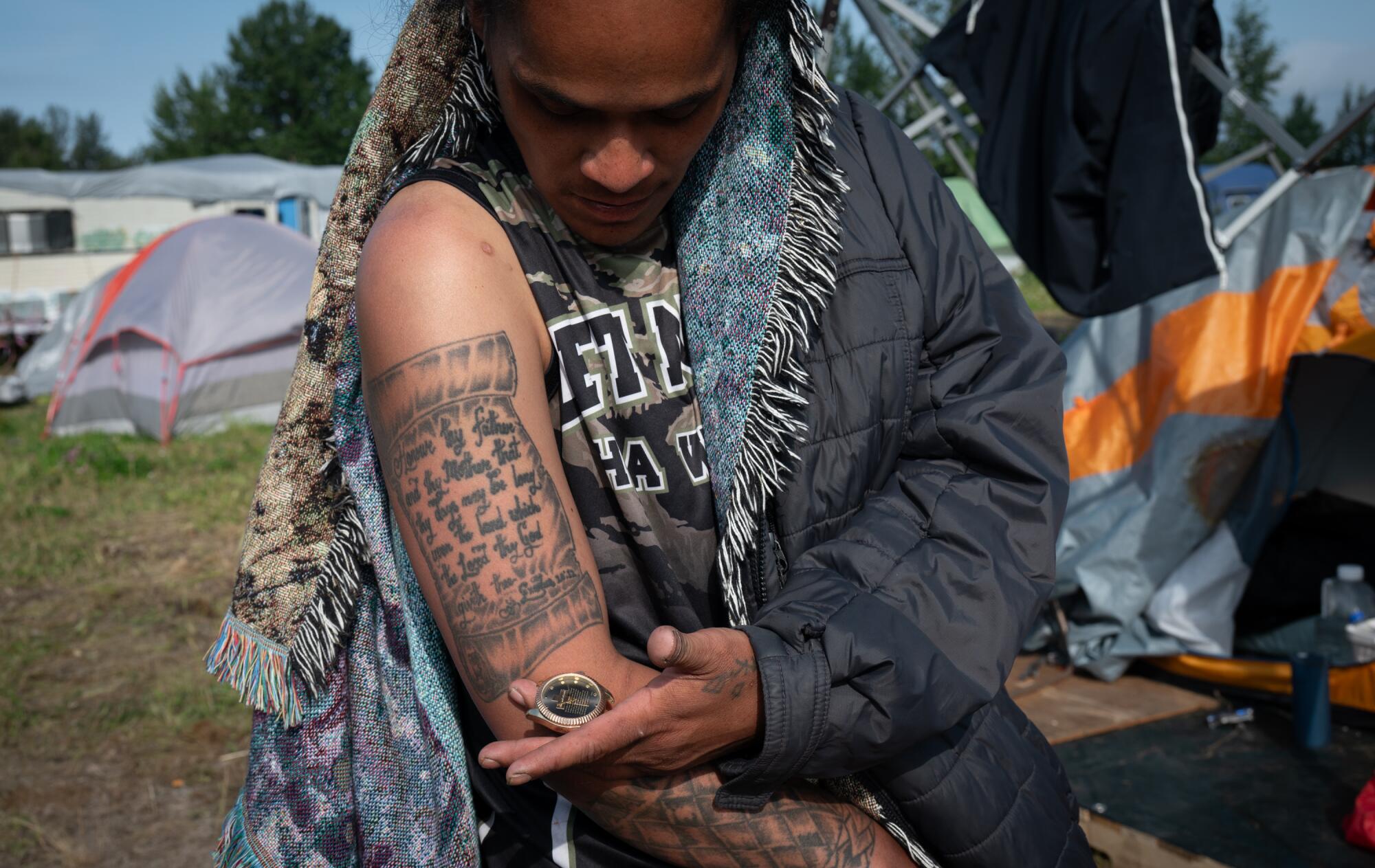
Her friend, Lae, a 30-year-old woman originally from Hawaii who would not give her full name, smoked a cigarette and shook her head in disgust.
Lae has the Fifth Commandment, “Honor Thy Father and Mother,” tattooed on her arm. She grinned as she pulled a large hatchet from her tent. She uses it to cut weeds. And for protection.
“Can you make our story seem happy?” she asked. “F— the mayor.”
She had another idea for Bronson. “There’s days where we don’t eat nothing,” she said. “The mayor should send us some pizza.”
John Tatham, who has run a custom printing business across the street since 1986, said the camp has never been this big.
His delivery van was recently stolen. He’s found people sleeping in the parking lot and had people “taking a dump in our doorway.”
Last week, Tatham, 75, heard several gunshots in the camp and watched a car speed out of there.
City leaders, he said, have largely been inept.
“You’re not going to solve it from behind a desk,” he said. “You’re going to have to get out there, roll up your sleeves, and engage with these people so you can separate the people who are truly homeless and truly needy and looking for a solution from the ones who are just taking advantage of the services.”
For those who truly want it, he said, a plane ticket wouldn’t be a bad option.
Times staff writer Ruben Vives contributed to this report.
- Share via
Watch L.A. Times Today at 7 p.m. on Spectrum News 1 on Channel 1 or live stream on the Spectrum News App. Palos Verdes Peninsula and Orange County viewers can watch on Cox Systems on channel 99.
More to Read
Sign up for Essential California
The most important California stories and recommendations in your inbox every morning.
You may occasionally receive promotional content from the Los Angeles Times.
